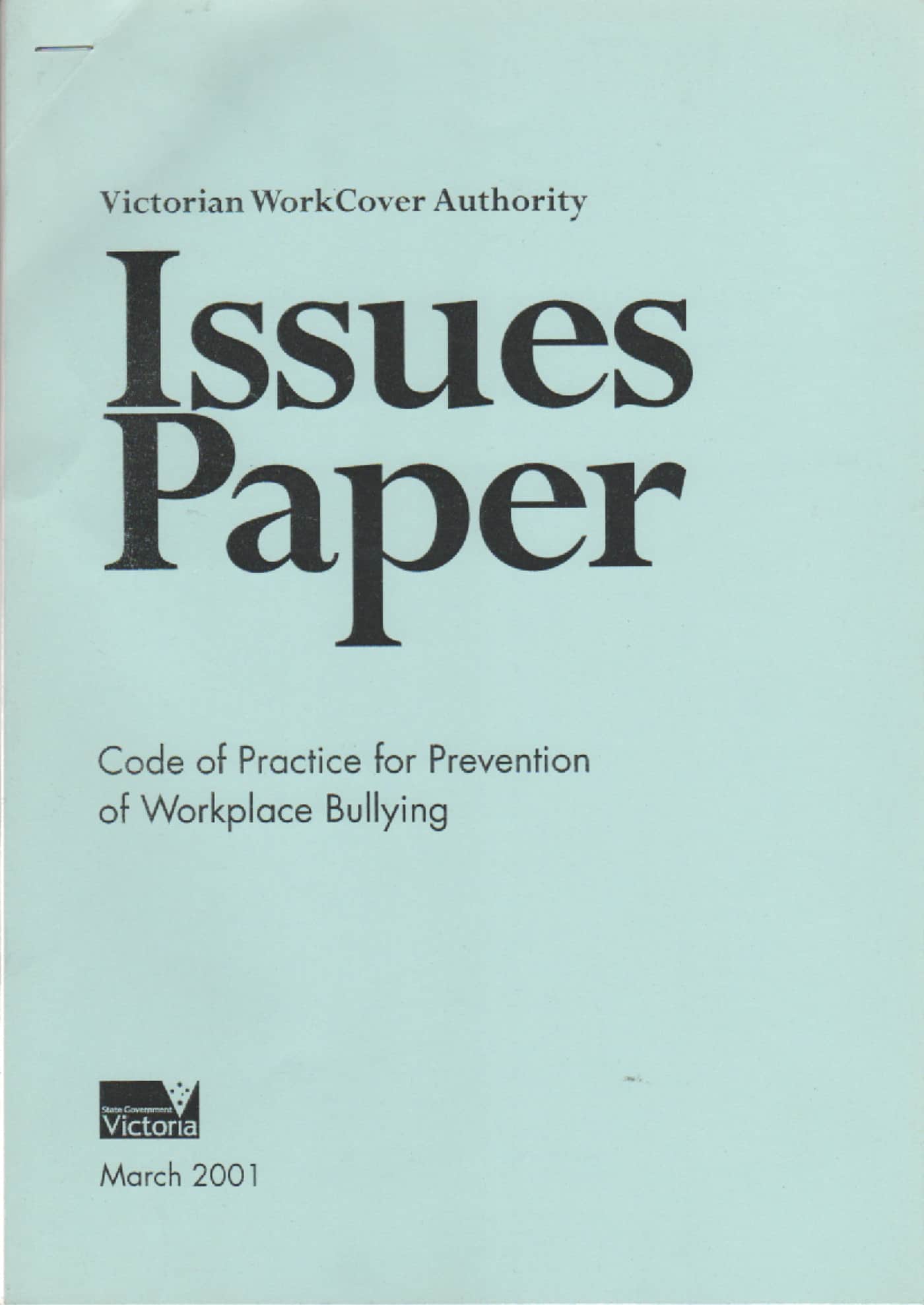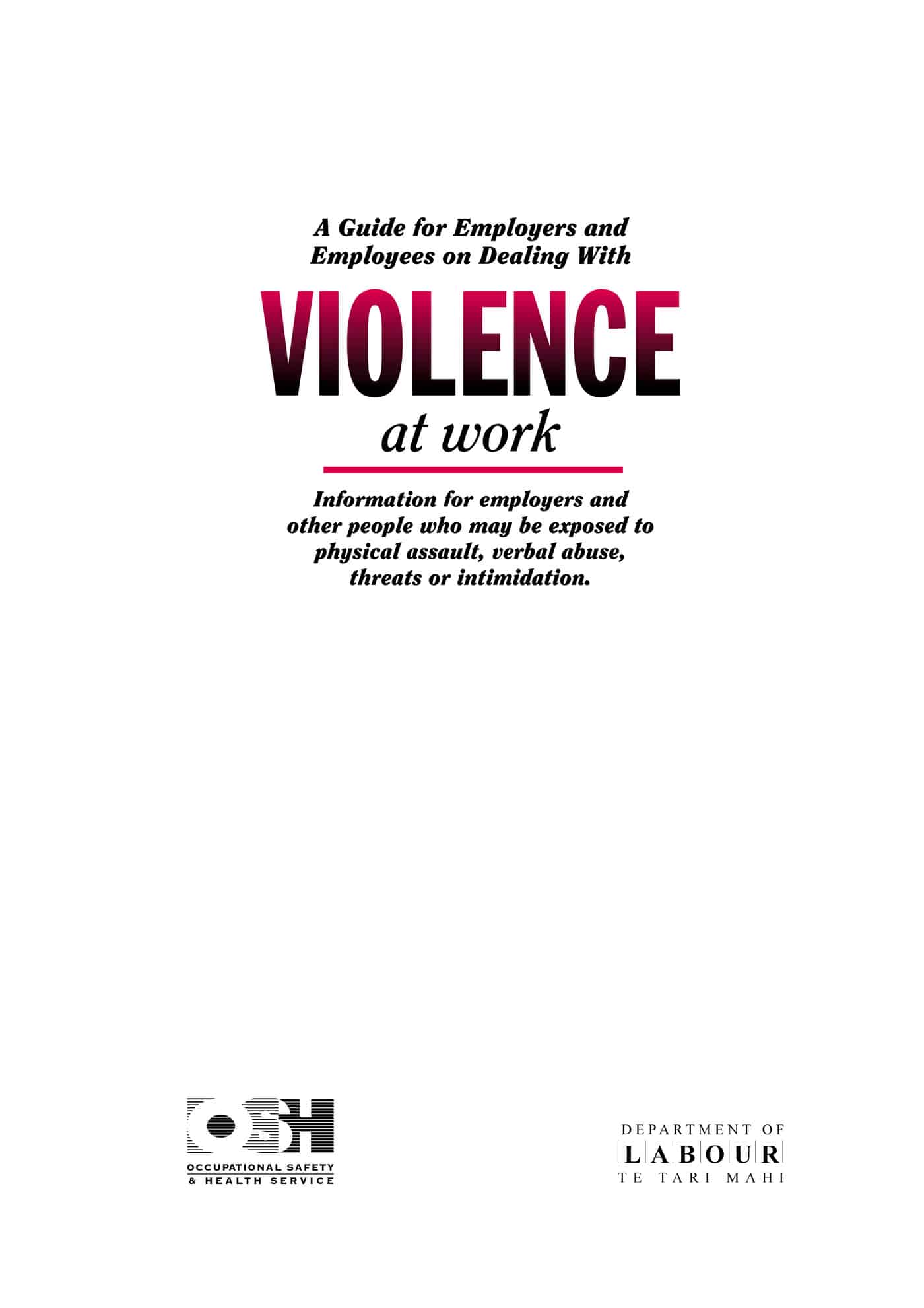Every year, around this time, the mainstream media reports on the findings of employee surveys of the Victorian public service. Each year the statistics on workplace bullying are featured. (The Age newspaper reported on the latest survey on 31 March 2013.) But the approach to an understanding of workplace bullying has changed over the last fifteen years or so. A brief look at the March 2001 Issues Paper on workplace bullying, released by the Victorian Workcover Authority (VWA), is useful to illustrate the degree of change but also the origin of some of the contemporary hazard control themes.
 The VWA Issues Paper was always intended to lead to a formal Code of Practice but due to belligerence from various industry bodies, no code eventuated and Victoria had to make do with a guidance note. This effectively banished workplace bullying to a nice-to-manage rather than an essential element of modern management. Significantly, Safe Work Australia intends to release a model Code of Practice on workplace bullying shortly. Perhaps the employer associations’ attitudes have mellowed. Perhaps it is the decline of trade union influence since 2001.
The VWA Issues Paper was always intended to lead to a formal Code of Practice but due to belligerence from various industry bodies, no code eventuated and Victoria had to make do with a guidance note. This effectively banished workplace bullying to a nice-to-manage rather than an essential element of modern management. Significantly, Safe Work Australia intends to release a model Code of Practice on workplace bullying shortly. Perhaps the employer associations’ attitudes have mellowed. Perhaps it is the decline of trade union influence since 2001.
The Issues Paper roughly defines workplace bullying as:
“…aggressive behaviour that intimidates, humiliates and/or undermines a person or group.”
This is quite different from the current definition preferred by Safe Work Australia:
“Repeated unreasonable behaviour directed toward a worker or group of workers that creates a risk to health and safety.”
The repetitive nature of workplace bullying was acknowledged in the Issues Paper, as was the concern that usual performance management practices may be interpreted as workplace bullying.
The paper identifies the causes of workplace bullying as being linked to
- “downsizing,
- increased hours of work,
- large workloads,
- lack of capacity to monitor and control one’s own work, and
- inadequate staffing levels.”
The causes of workplace bullying listed have changed little since 2001 and this begs the question, if these causes were identified in 2001 and earlier, why are the same causes turning up in 2013? There is also the implication that the guidances from around ten years ago have had little impact on the extent of workplace bullying.
The Issues Paper tried to quantify the extent of workplace bullying but struggled with the same statistical uncertainties that the recent Australian Parliamentary Inquiry faced. This inaccuracy and the role of perception is discussed in earlier blog articles.
Dignity At Work
In 2001, the failed Dignity At Work Bill in the UK was still a recent memory and the mention of that Bill in the Issues Paper is a recognition of the missed potential. The creation of the Dignity At Work Bill was a recognition that the increasing lack of respect in workplaces was a core element behind a range of workplace personnel issues. As the Dignity At Work Partnership website details:
“Giving employees dignity at work is likely to increase their positive feelings about their employer and their jobs. This might be expected to lead to greater willingness to accept change, learn new skills, pursue high standards of quality through pride in work, work as a team and so on.
Promoting dignity at work is likely to reduce stress and related health problems and absenteeism among those who are both suffering and close witnesses to bullying.
Time spent on the promotion of dignity at work policies is often better in outcomes than time spent on dealing with individual complaints of bullying and harassment.”
The goal of dignity at work can be seen underpinning many contemporary statements of the psychosocial health advocates.
Hierarchy of Controls
The Issues Paper posited that the traditional hierarchy of controls could not apply to workplace bullying due, principally, to the irrelevance of engineering controls. It suggested a range of horizontal controls that included:
- “Management/Supervision/Leadership.
At the highest intervention level the manager/supervisor should identify potential situations incidents and implement strategies, agreeable to all parties to eliminate bullying. This may include reviewing the organisation and management of work.
- Provide administrative systems within the workplace to enable early reporting and intervention to stop bullying behaviour.
- Provide awareness training, policies and procedures for employees and supervisors in workplaces where bullying is a predictable risk.
- Where bullying can be predicted, inform employees during induction training of the procedures in place aimed at identifying bullying behaviour and resolving incidents.
- Implement a recording system for details of all bullying incidents and establish follow up strategies as part of OHS management systems……
- If an incident of bullying does occur, it may be necessary to separate the parties into different work areas; provide counselling and support to the subject; and assist the perpetrator to recognise and change his/her behaviour.
Some of these controls may seem clunky in 2013 but the latest codes and guidances have similar recommendations.
The first bullet point remains the most challenging control option in suggesting a review of an organisation and the management of work. Yet it is also the one element that would result in a sustainable change to the safety culture of an organisation.
Previous OHS guidance
The VWA Issues Paper was one of the earliest OHS documents released to stimulate and, in some ways, steer, debate on workplace bullying but other Australian States had released similarly-themed Codes and guidances.
 ACT Workcover released a Guidance on Workplace Violence in 2000. In 1998 Queensland released Workplace Bullying: An Employers’ Guide and followed this in 1998 with “Violence at Work: A Workplace Health and Safety Guide”. In 1999 WorkSafe WA released a Code of Practice on Workplace Violence (the revised 2010 edition is HERE). In 2000, the Queensland Working Women’s Service published a Risky Business guide specifically addressing bullying. But all these were pipped by the New Zealand Department of Labour who released a violence at work guide in 1995.
ACT Workcover released a Guidance on Workplace Violence in 2000. In 1998 Queensland released Workplace Bullying: An Employers’ Guide and followed this in 1998 with “Violence at Work: A Workplace Health and Safety Guide”. In 1999 WorkSafe WA released a Code of Practice on Workplace Violence (the revised 2010 edition is HERE). In 2000, the Queensland Working Women’s Service published a Risky Business guide specifically addressing bullying. But all these were pipped by the New Zealand Department of Labour who released a violence at work guide in 1995.
At the time workplace bullying was just becoming separated from occupational violence. That overlap that was eventually resolved seems to have some similarities to the current perceived overlap with harassment.
Since 2001, there has been considerable analysis of workplace bullying but bullying remains a consistent concern. SafetyAtWorkBlog has said elsewhere that
“The debate on bullying is a distraction from the real workplace hazards of stress and mental health; hazards that are being ignored because effective controls can only be implemented if there is a substantial reassessment of how employers treat their labour.”
In many ways workplace bullying is another of those work issues of which people are aware but gains no traction to change. It is like fatigue management where sustainable change requires coordinated societal, organisational, corporate and legislative action. The size of this challenge scares everyone and so the only change occurring is that which is “as far as is reasonably practicable” but on psychosocial workplace issues reasonably practicable is insufficient. People continue to be hurt and damaged, mostly through no fault of their own.
The VWA Issues Paper is no longer available online or through the WorkSafe Victoria website. This is a shame because the paper reinforces that workplace bullying is not a new phenomenon and shows that many of the issues being discussed now have changed little in over a decade. To often OHS gets wrapped up in thinking that all hazards occur in the now and ignores recent history. Workplace bullying, occupational violence and psychosocial hazards are issues that benefit from a historical perspective even if that history is only twenty years.

Kevin – I read your posts on bullying with great interest. This article in particular hits a strong chord – and that is – why is it that we are still responding in the same thing (and debating the same issues) when it clearly has made little discernible pverall difference in decreasing bullying.
Additionally, the point that bullying is a cultural phenomena and therefore \’should\’ have whole of organisation cultural response seems on the whole to be totally missed by organisations. As you say if organisations do not understand the danger zones that exist in workplaces (or the economy, market place etc) and the relationship to bullying then preventative action and responses are significantly less likely to be implemented.
It also serves a purpose while organisations do not take this approach they can focus on seeing the problem as individually based and not cultural. As a conflict consultant my level of frustration at the inadequate response that organisations take to the issue is – today at an all time high!
Excellent article, as ever, Kevin.
I was fortunate to be able to work with HSE and HSL on the topics of stress and bullying whilst working in the UK. Here is a link to anyone interested in these topics http://www.hse.gov.uk/stress/furtheradvice/bullyingharassment.htm
Cheers…